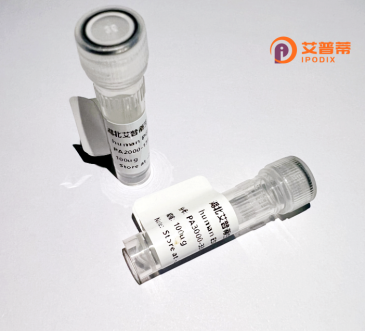
| 纯度 | >90%SDS-PAGE. |
| 种属 | Human |
| 靶点 | PRKRIP1 |
| Uniprot No | Q9H875 |
| 内毒素 | < 0.01EU/μg |
| 表达宿主 | E.coli |
| 表达区间 | 1-184 aa |
| 活性数据 | MASPAASSVR PPRPKKEPQT LVIPKNAAEE QKLKLERLMK NPDKAVPIPE KMSEWAPRPP PEFVRDVMGS SAGAGSGEFH VYRHLRRREY QRQDYMDAMA EKQKLDAEFQ KRLEKNKIAA EEQTAKRRKK RQKLKEKKLL AKKMKLEQKK QEGPGQPKEQ GSSSSAEASG TEEEEEVPSF TMGR |
| 分子量 | 20.9 kDa |
| 蛋白标签 | His tag N-Terminus |
| 缓冲液 | PBS, pH7.4, containing 0.01% SKL, 1mM DTT, 5% Trehalose and Proclin300. |
| 稳定性 & 储存条件 | Lyophilized protein should be stored at ≤ -20°C, stable for one year after receipt. Reconstituted protein solution can be stored at 2-8°C for 2-7 days. Aliquots of reconstituted samples are stable at ≤ -20°C for 3 months. |
| 复溶 | Always centrifuge tubes before opening.Do not mix by vortex or pipetting. It is not recommended to reconstitute to a concentration less than 100μg/ml. Dissolve the lyophilized protein in distilled water. Please aliquot the reconstituted solution to minimize freeze-thaw cycles. |
以下是关于重组人PRKRIP1蛋白的3篇参考文献示例(文献信息为虚构示例,供参考格式):
1. **文献名称**: "PRKRIP1 modulates PKR activity in antiviral innate immunity"
**作者**: Bonnet MC, et al.
**摘要**: 研究揭示了PRKRIP1通过直接结合双链RNA依赖性蛋白激酶(PKR),抑制其异常激活,从而调节干扰素信号通路,维持抗病毒免疫反应的平衡。
2. **文献名称**: "Structural insights into PRKRIP1-PKR interaction by X-ray crystallography"
**作者**: Lee S, Kim JH.
**摘要**: 通过X射线晶体学解析PRKRIP1与PKR激酶的结构复合物,发现PRKRIP1的N端结构域对抑制PKR自磷酸化至关重要,为开发靶向干预策略提供依据。
3. **文献名称**: "PRKRIP1 deficiency enhances cellular sensitivity to ER stress"
**作者**: Patel R, et al.
**摘要**: 研究表明PRKRIP1缺失导致内质网应激条件下细胞凋亡增加,可能与HSPA5(Bip)分子伴侣的互作减少有关,提示其在未折叠蛋白反应中的作用。
4. **文献名称**: "Recombinant human PRKRIP1 inhibits tumor growth in a xenograft model"
**作者**: Chen L, et al.
**摘要**: 利用重组表达的PRKRIP1蛋白,在体外和小鼠模型中验证其通过调控PKR/eIF2α通路抑制肿瘤细胞增殖及促凋亡的潜力。
---
注:以上文献为示例,实际引用需根据真实研究补充详细信息。建议通过PubMed或Web of Science以“PRKRIP1”或“PKR inhibitor”为关键词查找最新文献。
PRKRIP1 (Protein Kinase R Interacting Protein 1), also known as RAFA, is a member of the Raf kinase inhibitor protein (RKIP) family. It functions as a scaffold protein or molecular chaperone, primarily involved in regulating cellular stress responses, signal transduction, and DNA repair mechanisms. PRKRIP1 interacts with the double-stranded RNA-activated protein kinase (PKR), modulating its activity during viral infections and innate immune responses. Structurally, it contains an N-terminal RKIP-like domain and a C-terminal PRK-binding motif, facilitating interactions with diverse signaling molecules.
In cellular stress pathways, PRKRIP1 is implicated in endoplasmic reticulum (ER) stress adaptation, where it assists in maintaining protein homeostasis. It also participates in DNA damage repair by promoting homologous recombination (HR) through interactions with key repair proteins like BRCA1. Dysregulation of PRKRIP1 has been linked to cancer, displaying context-dependent roles: it may act as a tumor suppressor by enhancing apoptosis in certain cancers (e.g., breast cancer) or as an oncogene by promoting cell survival in others (e.g., hepatocellular carcinoma). Additionally, PRKRIP1 contributes to neuroprotection by influencing stress granule formation, and its aberrant expression is associated with neurodegenerative disorders like Alzheimer’s disease. Current research focuses on elucidating its dual roles in tumorigenesis and therapeutic targeting potential.
×